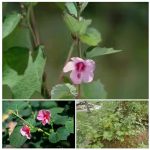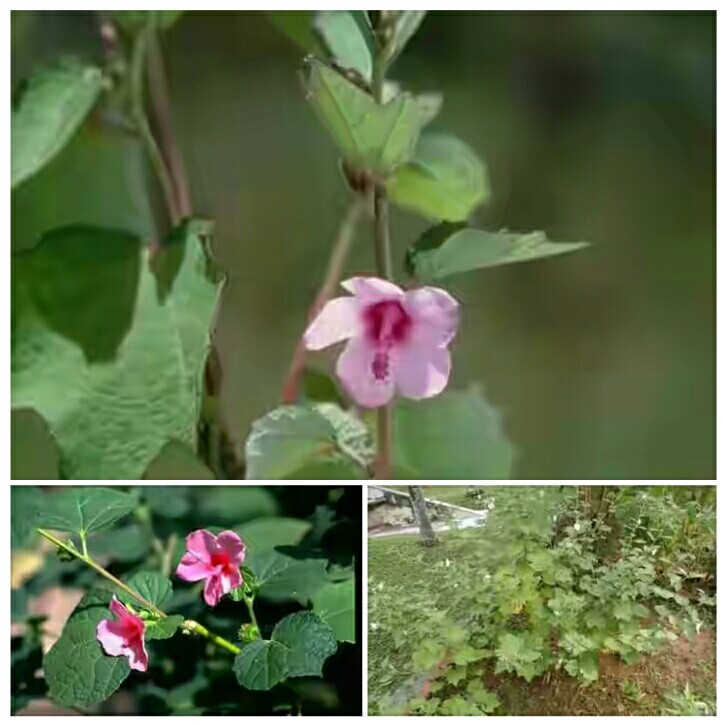Urena lobata; synonyms: Urena viminea Cav., Urena grandiflora DC (Botanical name) or Congo jute, Aramina, Bur-mallow, Cadillo, Weed Caesar, Hibiscus bur, Urena, Pink burr, Pink Chinese burr, Urena bur (English) or Igiyar rafi, Kafi rama, Kafi ramo, Rama rama, Ramaniya, Ramarana, Ramoramo, Uwar magani, Baƙin garmani (Hausa) or Ake iri, Ake riri (Yoruba): An edible and medicinal traditional fibre crop
DESCRIPTION AND OCCURRENCE: Kafi rama is an erect, branched shrub 0.6 to 2.5 meters high. The plant is exceedingly variable and more or less hairy, stems often with reddish branches. Leaves are pale beneath, ovate to suborbicular, 3 to 9 centimeters long, heart-shaped at the base, more or less toothed or somewhat lobed or angled, the lobes not exceeding beyond the middle of the leaf and the sinuses being usually broad and acute. Flowers are pink or purplish, about 1.7 millimeters in diameter and borne singly in the axils of the leaves, or somewhat in panicles. Petals are 5, free above, connate below and adnate to staminal tube; staminal tube truncate or minutely toothed, anthers many. Ovary is 5-celled, branches of stigma 10. Fruits are rounded but flattened and about 7 millimeters in diameter, with the 5 carpels covered with short, barbed spines. The origin of Urena lobata is not certain, but it is probably of African or Asian origin. It is now widely distributed in a wild or naturalised state throughout the tropics and subtropics. In tropical Africa it occurs naturally from Cape Verde and Senegal eastward to Ethiopia and Eritrea, and southward across the continent to South Africa. It also occurs in the Indian Ocean islands. Urena lobata is grown as a commercial fibre crop in DR Congo, and for local use in Ghana, Nigeria and elsewhere in tropical Africa; commercial fibre production in Angola and Madagascar is mainly based on wild or naturalized plants.
USES: Young shoots and leaves are eaten as a vegetable. In Malawi the flowers are eaten as a side-dish. The seeds contain oil and are mucilaginous and they are boiled in soups and with cereals. Cooked with rice they give it a pleasant slipperiness. Per 100 g edible portion, the raw leaves contain: water 81.8 g, energy 226 kJ (54 kcal), protein 3.2 g, fat 0.1 g, total carbohydrate (including fibre) 12.8 g, fibre 1.8 g, P 67 mg. The composition of Urena lobata forage (moisture content 79.4%) in southern Nigeria was on a dry matter basis: crude protein 15.3%, ether extract 2.0%, crude fibre 17.6%, ash 6.0%, silica 3.9%, N-free extract 59.1%. The seeds contain 7-18% oil, with linoleic acid, palmitic acid and oleic acid as major fatty acids, but also containing other polyunsaturated fatty acids. The fatty acid profile is favourable for the prevention and management of heart diseases.
THE MEDICINAL USES of URENA LOBATA
The uses are widespread and numerous worldwide. It is considered expectorant and emollient.
In the whole of Africa, the plant is used for the treatment of pneumonia, rheumatism, fevers, wounds, malaria, colds, dysentery, enteritis, goiter, indigestion, coughs, leukorrhea, rheumatism, tonsillitis and respiratory diseases.
In Côte d’Ivoire, a decoction of the plant is taken as oxytocic and against fever, in the Central African Republic against pneumonia.
In Nigeria, a preparation of the root is applied externally against rheumatism, a purpose for which it is also used e.g. in Vietnam.
In Zanzibar and Indonesia, a decoction of the root is taken against indigestion. In Madagascar, a preparation of the root is applied to treat infected eyelids and against syphilis. Scrapings of the stem bark are put on wounds.
In Gabon, a macerate of the stem bark or root is prescribed against diarrhoea. In Madagascar, a decoction of bark and root is given to children with enteritis or stomach pain.
The leaves are widely used to induce labour or facilitate childbirth. In Côte d’Ivoire, a preparation of the leaves with those of other plants is applied to treat menstrual problems. In Togo, women drink a decoction of the leaves and sometimes also from the stems and leaves of Vernonia cinerea (L.) against infertility.
In Benin, a maceration of the leaves is taken against infectious diarrhoea. In Congo, sap expressed from the leaves is given to women giving birth to their first child, and a leaf decoction is drunk against hypertension.
In DR Congo, powdered leaves with powdered clay in water are taken regularly as a treatment of asthma. In Uganda, leaves are used against snake-bites and a leaf infusion is taken against diarrhoea.
In Madagascar, sap from the leaves is dripped onto wounds and a poultice of boiled leaves is applied to rheumatic inflammations, while a poultice of leaves and seeds is applied against problems of the gall bladder and other intestinal complaints. In Guinea, water in which flowers are steeped is drunk as antiseptic. In Madagascar, a decoction of the flowers is taken against respiratory problems.
The plant is used in Ayurveda and Sidha. Paste from the whole plant is applied for the treatment of rheumatic pains. Twigs or stem cuttings are used as tooth brush for healthy gums. The flowers, together with those of Sida rhombifolia (Faskara Saiwo in Hausa), mixed with coconut flesh is eaten as a remedy for chickenpox.
Flowers heated over fire are applied to sores, to open and ease the infection. Flowers are included in the treatment for mental disorders and in oral remedies for fevers. Leaves are used to treat burns, scalds, heat, hangover, and fever while poultice from tender leaves is applied to wounds and cuts.
Pounded leaves boiled in coconut oil are applied to treat wounds and cuts. For swelling and bone fracture, a paste of fresh leaves is applied.
Leaves of Urena lobata along with the root of Vanda roxburghii prepared into a paste is applied for skin diseases. Leaf tea is diuretic and is used for flu and stomachache, colds, cough, heat. Leaf juice is applied as eye drop in conjunctivitis. Root has a diuretic effect and is used as infusion in postpartum.
Roots of Sida rhombifolia, Urena lobata, Elaeagnus caudate (silver berry) and stem bark and roots of Bixa Orellana (English annatto or Yellow dye) and Randia dumetorum (Chibra, tshibra in Hausa) pounded together and boiled in water, the extract taken to cure jaundice. Decoction of roots of Dillenia indica (Elephant apple) with roots of Ficus auriculata (Elephant ear fig tree) and Urena lobata are given in discharge of blood in urine.
A decoction of rhizome of Curcuma aromatica (Gangamau in Hausa) with roots of Urena lobata and leaves of Tolypanthus involucratus are given to expel catarrh. Roots and leaves are used to cure diarrhea. Root powder is given with milk in dog bite. Root extract is used as an external application in rheumatic pains, cuts and wounds. For snakebite, chew the root with betel and spit onto the wound.
FIBER/PAPER: Bast fiber of the plant is of the jute type is easier to extract than jute. Rope made from the fiber is fairly strong. In India, Japan and other countries, it is used as cordage material (sacks, carpets, upholstery).
In tropical Africa and elsewhere, Urena lobata serves for making string, twines, ropes, fishing lines and nets, and nets for hunting, while the unprocessed bark is often used as tying material. In Ghana, the stripped and plaited bark is used to bind loads. In Gabon, it is used to affix leaves for thatching. In Malawi, the stems are woven into walls of grain stores.
In Madagascar, the fibre is locally used in the manufacture of bags. The fibre of Urena lobata can be made into strong, bank-note quality paper and whole plants can be pulped as well. It is a favoured fiber in the manufacture of coffee bags because it does not affect the aroma of the coffee. Aramina fiber and Congo jute are produced in Brazil from the Urena lobata. The fiber also makes a strong paper, and said to be twice as strong as “Bank of England note pulp”.

FOR FURTHER READING:
1. Antidiarrheal activity of Lithocarpus dealbata and Urena lobata extracts: Therapeutic implications Yadav, A.K. and V. Tangpu, Pharmaceutical Biology, 2007. 45(3): p. 223-229.
2. Baert, J. & Raemaekers, R.H., 2001. Urena. In: Raemaekers, R.H. (Editor). Crop production in tropical Africa. DGIC (Directorate General for International Co-operation), Ministry of Foreign Affairs, External Trade and International Co-operation, Brussels, Belgium. pp. 1083–1086.
3. Burkill, H.M., 1997. The useful plants of West Tropical Africa. 2nd Edition. Volume 4, Families M–R. Royal Botanic Gardens, Kew, Richmond, United Kingdom. 969 pp.
4. Preliminary antihyperglycemic, a.a., phytochemical analysis and toxicity studies on leaves of Urena lobata L Islam, M. H., et al., Journal of Chemical and Pharmaceutical Research, 2015. 7(4): p. 559-563.
These are the thoughts and intellectual property of:
Sa’eed Halilu Bawa
Senior Lecturer (Associate Professor) at University of the West Indies, St. Augustine Campus, Trinidad.
Studied Food and Nutrition Sciences, Dietetics at Kaduna Polytechnic, Nigeria; Warsaw University of Life Sciences, Poland.
























